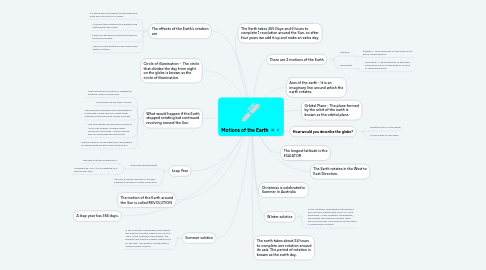Motions of the Earth
af Midnight Musician


1. The effects of the Earth’s rotation are
1.1. It causes days and nights on the Earth and each day consists of 24 hours.
1.2. It causes the bulging at the Equator and flattening at the Poles.
1.3. It gives us the idea of direction based on sunrise and sunset.
1.4. Tides are caused twice a day due to the Earth’s rotation.
2. Circle of illumination - The circle that divides the day from night on the globe is known as the circle of illumination.
3. What would happen if the Earth stopped rotating but continued revolving around the Sun
3.1. There would be 3 months of Nighttime, Daytime, Dawn & Dusk each.
3.2. Most plant life wouldn't survive.
3.3. The difference between the temperatures in the light & dark side will create huge changes in the Wind and Ocean currents.
3.4. The atmosphere would keep moving at 1000 MPF speeds, mowing down mountains and cities. Humans would end up flying with the wind too!!!
3.5. Natural balance would topple and everything including Earth will be forever extinct!!!!!!
4. The Earth takes 365 Days and 6 hours to complete 1 revolution around the Sun, so after four years we add it up and make an extra day.
5. The motion of the Earth around the Sun is called REVOLUTION
6. A leap year has 366 days.
7. Leap Year
7.1. Leap Year Requirements
7.1.1. The year must be divisible by 4
7.1.2. If divisible by 400, it is considered as a special leap year
7.2. The year in which February is 29 days instead of 28 days is called a leap year.
8. Summer solstice
8.1. In the Northern Hemisphere the longest day and the shortest night occur on 21st June. In the Southern Hemisphere, the shortest day and the longest night occur on this day. This position of the earth is called summer solstice.
9. How would you describe the globe?
9.1. Miniature form of the Earth
9.2. A true model of the Earth
10. The Earth rotates in the West to East Direction.
11. The longest latitude is the EQUATOR
12. There are 2 motions of the Earth
12.1. Rotation
12.1.1. Rotation - The movement of the earth on its axis is called rotation.
12.2. Revolution
12.2.1. Revolution - The movement of the earth around the sun in a fixed path or an orbit is called Revolution
